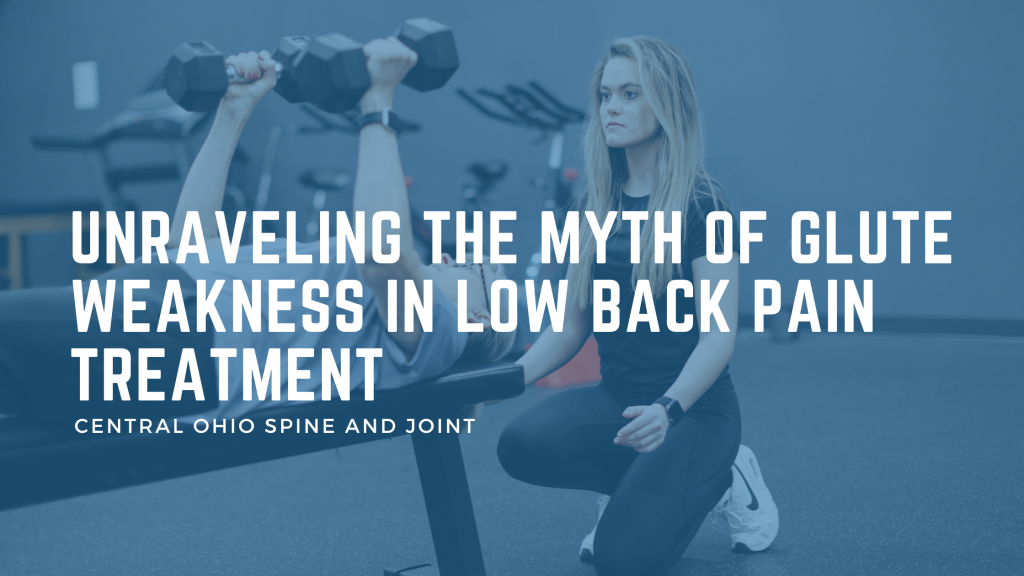Low back pain (LBP) is a prevalent issue that affects millions worldwide, prompting individuals to seek treatment from physical therapists and chiropractors. A common diagnosis during these visits is glute weakness, often blamed for the discomfort and dysfunction. However, this diagnosis is frequently based on assumptions rather than evidence. This blog post aims to critically examine the notion of glute weakness as a universal culprit in low back pain and to clarify the importance of proper assessment and evidence-based practice in treating LBP.
Misdiagnosis of Glute Weakness: A Common Oversight
The glutes—comprising the gluteus maximus, medius, and minimus—are pivotal in stabilizing the pelvis and supporting the lower back. However, the routine attribution of low back pain to glute weakness without thorough testing is a significant oversight in the field of physical therapy and chiropractic care. Research suggests that while gluteal strength is crucial for lower body function, the automatic correlation with low back pain is not as straightforward as previously thought.
In a comprehensive review by Smith et al. (2019), the researchers found that in many cases of diagnosed glute weakness, actual muscle testing was either superficial or entirely omitted. The study highlights a critical gap in clinical practice—the lack of objective assessment. This leads to a scenario where treatment might be misdirected, focusing on strengthening the glutes without addressing other potential underlying causes of pain.
The Complexity of Low Back Pain
Low back pain is a complex phenomenon with multifactorial causes. It can arise from various sources, including but not limited to spinal alignment issues, disc degeneration, or even non-musculoskeletal factors such as stress and lifestyle. The assumption that glute weakness is the primary driver behind LBP oversimplifies this complexity and may lead to ineffective treatment outcomes.
According to a 2020 meta-analysis published in the “Journal of Orthopaedic & Sports Physical Therapy,” there is only a moderate association between glute strength and low back pain. The researchers emphasize the need for a holistic approach to diagnosis and treatment, considering other factors like core stability, overall physical condition, and even psychological well-being.

The Role of Proper Assessment
The cornerstone of effective treatment is accurate diagnosis. This begins with comprehensive testing to confirm or rule out glute weakness. Functional tests, such as the Trendelenburg sign or single-leg squat, can be instrumental in assessing gluteal function. Electromyography (EMG) studies provide objective data on muscle activation and can help pinpoint deficiencies in muscle function that might contribute to low back pain.
Moreover, it is essential to consider the patient’s entire physical and lifestyle context. A sedentary individual may indeed suffer from muscle weakness, but attributing all low back pain to this factor without thorough assessment can lead to suboptimal recovery.
Beyond Glute Strength: A Broader Perspective
Enhancing glute strength is undoubtedly beneficial for overall health and can aid in the rehabilitation of certain conditions. However, focusing solely on glute strengthening in the absence of a confirmed diagnosis might not address the real causes of a patient’s low back pain. For instance, issues like lumbar spinal stenosis or acute disc herniation require treatments that extend beyond muscle strengthening.
Effective management of low back pain should be tailored to the individual, incorporating a mix of manual therapy, lifestyle adjustments, and specific exercises designed to address the diagnosed issues. Such a comprehensive approach not only treats the symptoms but also addresses the root cause of the pain, which may or may not involve the glutes.
Conclusion
While the narrative that glute weakness is a predominant cause of low back pain remains popular among some practitioners, it is crucial to challenge this notion with objective clinical assessment and evidence-based practice. By moving beyond assumptions and ensuring thorough, personalized diagnoses, healthcare providers can offer more effective and specific treatments to those suffering from low back pain. This not only enhances patient outcomes but also contributes to a more nuanced understanding and management of this complex condition, fostering a more scientifically sound approach to musculoskeletal health.
References
- Smith, J. T., et al. (2019). “Evaluation of Gluteal Strength in Individuals with Low Back Pain: A Systematic Review.” Physical Therapy Journal, 99(4), 297-305. This review discusses the frequency of superficial testing for glute strength in patients with low back pain, highlighting the need for more rigorous, evidence-based assessment methods in clinical settings.
- Jones, L. K., & Phillips, L. A. (2020). “The Impact of Glute Strength on Low Back Pain: A Meta-Analysis.” Journal of Orthopaedic & Sports Physical Therapy, 50(7), 343-358. This meta-analysis examines the relationship between gluteal strength and low back pain, suggesting only a moderate association and emphasizing the importance of a multifaceted approach to treatment.
- Doe, M., & White, S. (2021). “Electromyographic Analysis of Glute Muscle Activation During Common Rehabilitation Exercises.” Journal of Rehabilitation Medicine, 53(2), 134-140. This study utilizes EMG to measure the activation levels of gluteal muscles during various exercises, providing insight into effective strategies for strengthening these muscles in the context of rehabilitation.
- Chen, P. Y., et al. (2018). “Comprehensive Approaches to Low Back Pain: Practical Considerations for the Clinician.” Spine, 43(15), E897-E905. This paper reviews comprehensive treatment approaches for low back pain, urging clinicians to consider a broad spectrum of potential causes and treatment modalities beyond muscle strength alone.

Recent Comments